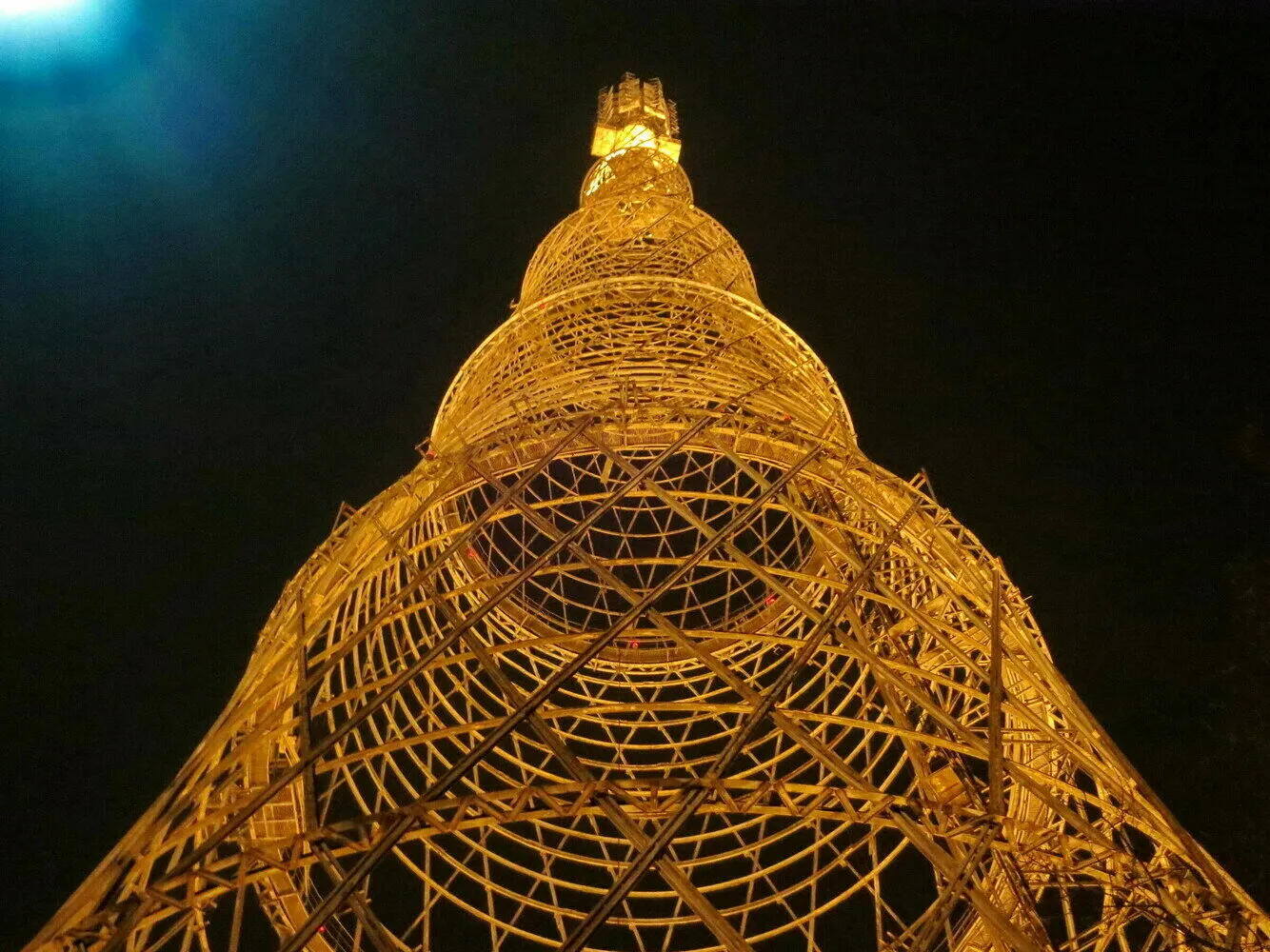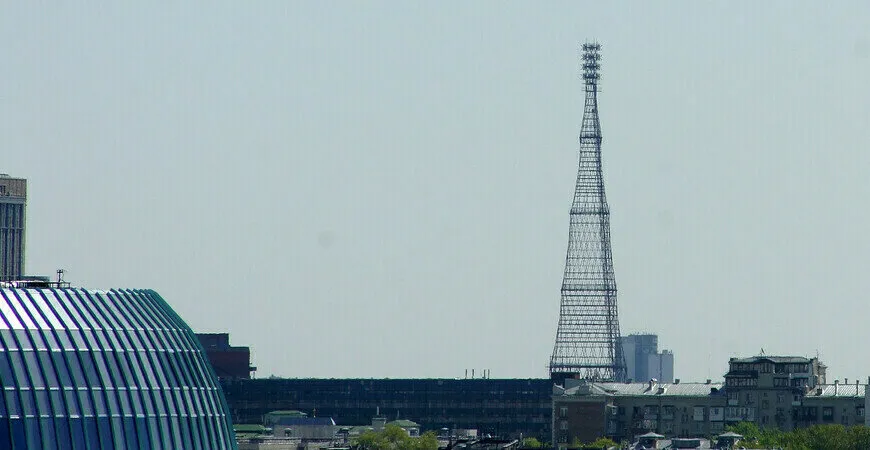There can be your advertisement
300x150
Shukhov Tower: Constructivist Eiffel Tower of Moscow
Design embodying brightness and lightness
Imagine: 1922, chaos after the Civil War, famine, lack of metal and construction materials. And suddenly, a 160-meter latticed tower grows on Shabolovka, appearing weightless despite its solid 240-ton weight. A colossal engineering marvel woven from metal rods in the form of a hyperboloid grid. Why was it needed by the young Soviet republic? How was it assembled without a single crane? And why do experts consider it more genius than the Eiffel Tower, even though it is twice as short?
Articles on the topic:
- "The Fallen Skyscraper": The History of One of Moscow's Most Unusual Buildings
- House on Kotelnicheskaya Embankment
- How the Palace Became a Station: The History of Kazan Railway Station
- The Mysteries of the Ryabushinsky Mansion: Modernist Architecture by Scheherazade and a Hidden Old Believer Prayer Room
Tower born from a formula
The name of Vladimir Shukhov was well known in Russia even before the construction of the tower—this self-taught engineer created the first oil pipelines and oil tankers in the world, built revolutionary bridges and hyperboloid water towers. Under his hands, mathematical formulas and physical laws transformed into elegant yet incredibly strong structures.
The idea of the hyperboloid structure came to Shukhov allegedly when he looked at an inverted woven basket—engineers noticed how thin rods crossing each other created a remarkably rigid and stable shape. This geometric figure—a single-sheet hyperboloid of revolution—was known to mathematicians, but Shukhov was the first to realize its application in construction.
In 1896, at the All-Russia Exhibition in Nizhny Novgorod, Shukhov presented the first hyperboloid tower in the world, 32 meters high. The structure amazed viewers with its weightlessness and strength. The secret was simple: the mesh hyperboloid consists of straight steel rods arranged at angles to each other. With such geometry, the structure becomes incredibly stable even with minimal weight.
 Photo: pinterest.com
Photo: pinterest.comRadio for the Revolution
Why did the Soviet government decide to build the tower? The reason was that after the revolution, the young republic found itself under an information blockade. It was urgently necessary to establish radio communication with the entire country and the world for spreading news and propaganda. For this purpose, a high radio mast was required.
In July 1919, Lenin signed an order to build a radio station with a 350-meter tower—taller than the Eiffel Tower! The project was assigned to Shukhov. However, due to metal shortages, the height had to be reduced to 160 meters, and Shukhov developed a genius solution that allowed saving metal—the modular hyperboloid structure.
The tower consisted of six modular hyperboloids stacked on top of each other. Each subsequent section was smaller in diameter than the previous one, creating a tapering silhouette towards the top. With a total height of 160 meters, the tower weighed only 240 tons—7.5 times lighter than the Eiffel Tower, which was 320 meters tall and weighed 7,300 tons!
 Photo: pinterest.com
Photo: pinterest.comHow was the Tower Built Without Cranes?
Building the tower was a separate engineering feat. In the conditions of chaos and lack of machinery, Shukhov invented a genius method of "telescopic assembly." First, the first, lower section of the tower was assembled on the ground. Then, using manual winches, it was raised and installed above the first section. A wooden deck was then placed on top to assemble the second, smaller section. The second section was then raised to lift the first one, freeing space for assembling the third. And so on—the tower literally grew from within!
As eyewitnesses reported, when builders were raising the first section, a cable snapped—causing an accident. The structure tilted but did not collapse—it merely lowered slightly. Shukhov, who was overseeing the work, was standing under the tower at that moment. He didn't run but calmly watched the accident, demonstrating absolute confidence in his construction. After replacing the cable, work continued successfully.
Additionally, construction took place during harsh winter conditions of 1919-1920. Temperatures dropped to -25°C, there was no warm clothing, and workers suffered from hunger and cold. Shukhov himself invented a special mounting method that accounted for metal expansion and contraction due to temperature differences. It is said he personally inspected each weld, climbing up the icy structures to dizzying heights despite his advanced age (the engineer was already 67 years old).
 Photo: pinterest.com
Photo: pinterest.comAlmost Shot for Engineering Calculation
Shukhov's engineering genius nearly cost him his life. Originally, the tower was to be 350 meters tall—taller than the Eiffel Tower! But calculations showed that for such height, with acute metal shortages in the country during the Civil War, 2000 tons of steel would be required—impossible under wartime conditions.
Shukhov adjusted the project to 160 meters. However, Soviet leadership interpreted this as sabotage. The VSNKh (Higher Council of National Economy) appealed to the GPU (Cheka) for "appropriate measures against Shukhov." At that time, such phrasing usually meant arrest and execution.
Shukhov was saved only by personal intervention from Krasin—people's commissar of trade and industry—who was an engineer by training and understood the fairness of Shukhov's calculations. Construction continued according to the corrected project, and on March 19, 1922, the flag was raised on the tower.
Looking 50 Years Ahead
The Shukhov Tower's design was so revolutionary that it outpaced its time by about half a century. Principles laid down by Shukhov in his mesh hyperboloid structure were only widely adopted in global architecture in the 1970s!
Famous German architect Frei Otto, who studied Shukhov's work, said: "What is now created using the most complex mathematical calculations and computers was done by Shukhov with a ruler and pencil on a kulieman."
Among modern architectural structures inspired by Shukhov's ideas are the 610-meter television tower in Guangzhou (China), built in 2010, the famous "Cucumber" skyscraper (30 St Mary Axe) in London designed by Norman Foster, and many other notable structures around the world.
Save the Tower from Oblivion
Paradoxically, this unique structure, having survived wars, revolutions, and political regime changes, is now under threat of disappearing. Since 2002, the tower has been closed to visits due to emergency conditions. Metal structures suffer from corrosion, and the surrounding area is built up in such a way that it's nearly impossible to fully inspect the tower.
Over the years, various projects were proposed for restoring the tower—from simple restoration to relocating the structure elsewhere. In 2014, the Ministry of Communications, which owns the tower, even claimed plans to dismantle it for safety reasons. However, under public and expert pressure, the object was recognized as a federal cultural heritage site, protecting it from demolition.
Today, restoration work is ongoing, but the tower's future remains uncertain. Meanwhile, UNESCO experts are considering including the Shukhov Tower in the World Heritage List as a unique monument of early 20th-century engineering thought.
 Photo: pinterest.com
Photo: pinterest.comTower Without Panels
Did you know that the Shukhov Tower was originally intended to become a grand artistic object as well? One of the projects planned panels with Soviet symbolism on its sections, visible from afar. Fortunately for the purity of the engineering form, this idea was abandoned, preserving the elegance of the structure.
Another interesting fact: during the Great Patriotic War, the Shukhov Tower was not bombed, despite being a crucial strategic object. According to one legend, Hitler ordered to preserve this structure so that it could be used as a tower for a triumphant address to the German people after the planned capture of Moscow. Another, more prosaic version says that the latticed structure was simply too complex a target for bombing of that era.
Today, looking at the whimsical outlines of the Shukhov Tower, one inevitably admires the genius of the engineer who created a structure in an age of paper drawings and logarithmic scales that is still considered the benchmark of technical aesthetics and rationality.
As famous architect Norman Foster wrote in 1999: "Vladimir Shukhov is one of the greatest engineers in the world. His structures embody brightness and lightness, characteristic of the heroic period of modernism." Architect Rolf Colacchini called the Shukhov Tower "the only architectural masterpiece of the country." While one might dispute the latter statement, the greatness of this engineering structure, combining mathematical harmony, aesthetics, and revolutionary technology for its time, remains undeniable.
Cover: pinterest.com
More articles:
 How to Decorate a Compact Apartment: 6 Great Ideas
How to Decorate a Compact Apartment: 6 Great Ideas Where to Store Things in a Small Bathroom: 10 Cool Solutions
Where to Store Things in a Small Bathroom: 10 Cool Solutions Budget Renovation Doesn't Mean Poor Quality: Secret Tips for Saving Money Without Sacrificing Standards
Budget Renovation Doesn't Mean Poor Quality: Secret Tips for Saving Money Without Sacrificing Standards Where to Save and When to Pay More in 2025: Analyzing Every Expense Category
Where to Save and When to Pay More in 2025: Analyzing Every Expense Category 7 budget-friendly stylish ideas for a cozy and functional interior
7 budget-friendly stylish ideas for a cozy and functional interior Small Inspiring Bathroom in a 40 m² Studio Apartment
Small Inspiring Bathroom in a 40 m² Studio Apartment Before and After: Transformation of a 110 m² Apartment Designer in a Heritage House
Before and After: Transformation of a 110 m² Apartment Designer in a Heritage House 6 bedrooms that will delight you
6 bedrooms that will delight you